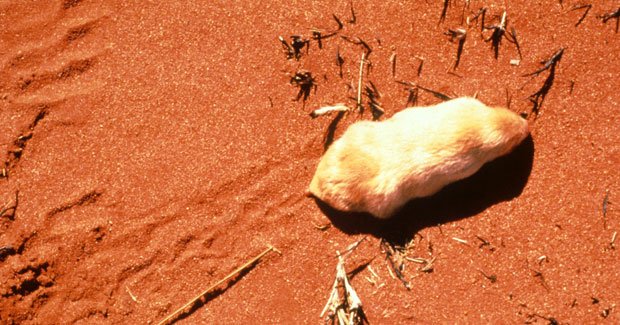Searching for the marsupial mole

These things we know: the marsupial mole has no eyes; only the faintest trace of ears; sharp, shovel-like claws for hands and a hard, horny pad for a nose. An adult weighs about 50 g and grows to about 12 cm. It spends its entire life underground, travelling through sand by digging with its claws, pushing with its nose, chest and shoulders, and backfilling its tunnel as it goes.
This small creature feeds on ants, termites, grasshoppers and seeds. We know females have pouches and two teats and males have an internal scrotum, but we don’t know how they reproduce, how often, or even how they find each other to mate. We know their habitat is the lightly cemented sand so typical of Australia’s deserts, but we don’t know how many there are or what their distribution is.
Geophone surveillance
They’re officially regarded as endangered, but recent studies led by Joe Benshemesh of La Trobe University, Melbourne, have shown this might not be the case. Using a combination of geophone surveillance, or sound monitoring, and digging trenches for signs of tunnelling, Joe has made some surprising discoveries.
“In very good mole country, such as around Uluru/Ayers Rock and Watarrka National Park, you’ll have 70-90 per cent chance of finding tunnels in your trenches,” he says. “In one place, we estimated around 90 km of tunnels in the space of 1 ha.” While scientists are yet to determine the age of tunnels and how far one mole can travel, Joe suspects the mole may be far more common than previously suspected. “It may in fact be one of the most common marsupials in the arid zone,” he says.
Interesting absence
Joe joined the Australian Geographic Society’s ninth scientific expedition to search for signs of the itjaritjari, or southern marsupial mole, in the Simpson Desert. It has so far been found throughout the Great Victoria Desert and the southern NT. In the Simpson, itjaritjari have been recorded on the desert’s western edge and as far as Poeppel Corner in the east, but they’re yet to be found in the north-eastern regions.
With the help of volunteers, Joe dug 25 trenches 1 m deep and 80 cm long, over a wide area of the sandier southern reaches of the expedition’s study area. No signs of tunnels were found.
“In some senses, the absence of the moles is more interesting than their presence,” Joe says. “It means we have to rework our idea of what constitutes marsupial mole country and what landscapes pose barriers.”

